View in other NatureServe Network Field Guides
NatureServe
Montana
Utah
Wyoming
Idaho
Wisconsin
British Columbia
South Carolina
Yukon
California
New York
Long Dash - Polites mystic
Native Species
Global Rank:
G5
State Rank:
S5
Agency Status
USFWS:
USFS:
BLM:
External Links
General Description
[From Ferris and Brown 1981; Scott 1986; Layberry et al. 1998; Opler and Wright 1999; Glassberg 2001; Pyle 2002] Forewing 1.4-1.5 cm. Uppersurface of male forewing with long slightly curved stigma (scent patch), may or may not be connected to dash extending to dark wing margin (creating the long dash); hindwing orange-brown with contrasting curved postmedian band of equal-sized yellow spots. Female uppersurface with broad black basal patch on forewing, otherwise similar to male. Undersurface of hindwing varies from yellow-orange to reddish brown, with postmedian band of larger pale yellow spots and a pale yellow basal spot.
Phenology
One flight, mid-June through July in most of range; two flights, June to early September in Michigan, late May to June and early August along east coast (Scott 1986). Mainly June and July but sometimes to mid-August (Glassberg 2001). June to late July, to mid-August in prairies, in Canada (Layberry et al. 1998). June and July in Rocky Mountain states (Ferris and Brown 1981). Late June to late July in northcentral Nebraska (Dankert and Nagel 1988), mid-June to early August in North Dakota (McCabe and Post 1976), early June to early August in Washington (Pyle 2002), mid-June to mid-July in British Columbia (Threatful 1988; Guppy and Shepard 2001).
Diagnostic Characteristics
Best determined by a combination of uppersurface of male forewing with long slightly curved stigma (scent patch), may or may not be connected to dash extending to dark wing margin (creating the long dash), female pattern similar; undersurface of forewing with black basal area, both surfaces of hindwing vary from yellow-orange to reddish brown with dark border, with postmedian band of larger pale yellow spots and a pale yellow basal spot.
Species Range
Montana Range
Range Descriptions
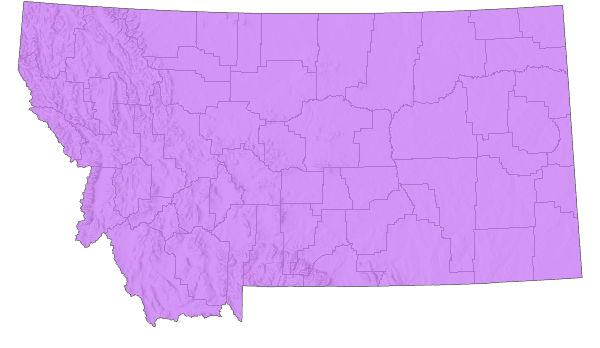
 Native
Native
Range Comments
Southern British Columbia and northwestern Washington, east through northern Idaho to eastern Ontario and Nova Scotia, south to central Arizona (isolated), southwestern Colorado (isolated), northeastern Colorado, northern Nebraska, southern Iowa, southern Ohio, southern Virginia (Scott 1986; Opler and Wright 1999; Glassberg 2001); to 2134 m elevation in the Rocky Mountain states (Ferris and Brown 1981), to 549 m elevation in southeastern British Columbia (Threatful 1988). In Montana, reported from at least 30 counties across the state (Kohler 1980; Stanford and Opler 1993; FLMNH Lepidopterists' Society database), to at least 1524 m elevation. Mainly uncommon to common, locally rare at western range margin (Glassberg 2001).
Observations in Montana Natural Heritage Program Database
Number of Observations: 14
(Click on the following maps and charts to see full sized version)
Map Help and Descriptions
Relative Density
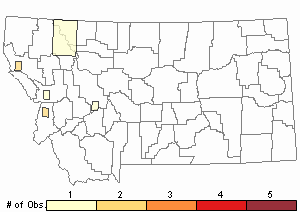
Recency
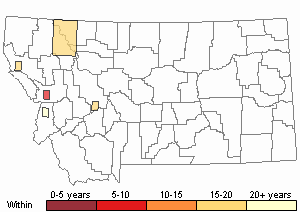
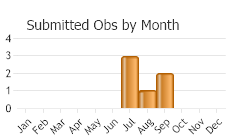
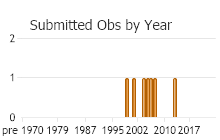
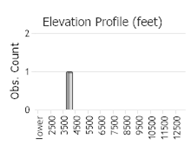 (Observations spanning multiple months or years are excluded from time charts)
(Observations spanning multiple months or years are excluded from time charts)
Migration
Non-migratory.
Habitat
Moist grassy areas, montane meadows, prairie swales, streamsides, moist floodplains, roadside ditches, marshes (Ferris and Brown 1981; Scott 1986; Dankert and Nagel 1988; Threatful 1988; Opler and Wright 1999; Glassberg 2001); most abundant in midwestern fields, less so in barrens and native prairie patches (Swengel and Swengel 2015).
Food Habits
Larval food plants are grasses, including Agrostis, Calamagrostis, and Poa (several species), possibly Agropyron, Echinochloa, Phleum, and possibly sedge (Carex) (Scott 1986, 1992, 2006; Layberry et al. 1998); also Bromus, Lolium, Setaria in captivity (James and Nunnallee 2011). Adults feed on flower nectar (including Apocynum, Asclepias, Carduus, Cirsium, Clematis, Convolvulus, Cryptantha, Eriogonum, Gaillardia, Geranium, Hackelia, Heterotheca, Leucanthemum, Lupinus, Medicago, Mentha, Monarda, Oxytropis, Penstemon, Prunella, Taraxacum, Trifolium) and mud (Pyle 2002; James and Nunnallee 2011; Scott 2014).
Reproductive Characteristics
Females lay eggs singly on or near host (sometimes dropped from host onto litter) (Scott 1986, 1992, 2006); a captive female laid 10 eggs in three days, two females laid about 80 eggs in one day, two females laid about 300 eggs in four days. Eggs hatch in about 8 days, develop from L1 instar to L3 instar in about 17 days, L3 instar overwinters (hibernates) or develops to L4 instar in about 28-35 days before overwintering, depending on temperature, develop to L5 instar and pupae in about 34-40 days post overwintering, adults eclose (emerge from pupae) in 11-14 days (Scott 1979, 1992; James and Nunnallee 2011). Larvae feed on host plant leaves, live in silk-tied tubular leaf nests, feed nocturnally, pupate in silken cocoon within final leaf nest or on neaby surface (Scott 1986, 1992, 2006; James and Nunnallee 2011). Males perch throughout the day in low spots of meadows, grassy streamsides to await passing females (Scott 1975b, 1986).
Stewardship Responsibility
References
- Additional ReferencesLegend:
 View Online Publication
View Online Publication
Do you know of a citation we're missing? Allen, T.J., J.P. Brock, and J. Glassberg. 2005. Caterpillars in the field and garden: a field guide to the butterfly caterpillars of North America. Oxford University Press.
Allen, T.J., J.P. Brock, and J. Glassberg. 2005. Caterpillars in the field and garden: a field guide to the butterfly caterpillars of North America. Oxford University Press. Brock, J.P. and K. Kaufman. 2003. Kaufman Field Guide to Butterflies of North America. Houghton Mifflin Company, New York, NY 284 pp.
Brock, J.P. and K. Kaufman. 2003. Kaufman Field Guide to Butterflies of North America. Houghton Mifflin Company, New York, NY 284 pp. Dankert, N.E. and H.G. Nagel. 1988. Butterflies of the Niobrara Valley Preserve, Nebraska. Transactions of the Nebraska Academy of Sciences 16:17-30.
Dankert, N.E. and H.G. Nagel. 1988. Butterflies of the Niobrara Valley Preserve, Nebraska. Transactions of the Nebraska Academy of Sciences 16:17-30. Forister, M.L., C.A. Halsch, C.C. Nice, J.A. Fordyce, T.E. Dilts, J.C. Oliver, K.L. Prudic, A.M. Shapiro, J.K. Wilson, J. Glassberg. 2021. Fewer butterflies seen by community scientists across the warming and drying landscapes of the American West. Science 371:1042-1045.
Forister, M.L., C.A. Halsch, C.C. Nice, J.A. Fordyce, T.E. Dilts, J.C. Oliver, K.L. Prudic, A.M. Shapiro, J.K. Wilson, J. Glassberg. 2021. Fewer butterflies seen by community scientists across the warming and drying landscapes of the American West. Science 371:1042-1045. Forister, M.L., E.M. Grames, C.A. Halsch, K.J. Burls, C.F. Carroll, K.L. Bell, J.P. Jahner, et al. 2023. Assessing risk for butterflies in the context of climate change, demographic uncertainty, and heterogeneous data sources. Ecological Monographs 93(3):e1584. https://doi.org/10.1002/ecm.1584
Forister, M.L., E.M. Grames, C.A. Halsch, K.J. Burls, C.F. Carroll, K.L. Bell, J.P. Jahner, et al. 2023. Assessing risk for butterflies in the context of climate change, demographic uncertainty, and heterogeneous data sources. Ecological Monographs 93(3):e1584. https://doi.org/10.1002/ecm.1584 Fultz, J.E. 2005. Effects of shelterwood management on flower-visiting insects and their floral resources. M.Sc. Thesis. Bozeman, MT: Montana State University. 163 p.
Fultz, J.E. 2005. Effects of shelterwood management on flower-visiting insects and their floral resources. M.Sc. Thesis. Bozeman, MT: Montana State University. 163 p. Glassberg, J. 2001. Butterflies through Binoculars: A Field Guide to the Butterflies of Western North America. Oxford University Press.
Glassberg, J. 2001. Butterflies through Binoculars: A Field Guide to the Butterflies of Western North America. Oxford University Press. James, D.G. and D. Nunnallee. 2011. Life histories of Cascadia butterflies. Corvallis, OR: Oregon State University Press. 447 p.
James, D.G. and D. Nunnallee. 2011. Life histories of Cascadia butterflies. Corvallis, OR: Oregon State University Press. 447 p. Layberry, R.A., P.W. Hall, and J.D. LaFontaine. 1998. The Butterflies of Canada. University of Toronto Press. 280 pp. + color plates.
Layberry, R.A., P.W. Hall, and J.D. LaFontaine. 1998. The Butterflies of Canada. University of Toronto Press. 280 pp. + color plates. McCabe, T.L. and R.L. Post. 1976. North Dakota butterfly calendar (including possible strays). Journal of Research on the Lepidoptera 15:93-99.
McCabe, T.L. and R.L. Post. 1976. North Dakota butterfly calendar (including possible strays). Journal of Research on the Lepidoptera 15:93-99. Sater, S. 2022. The insects of Sevenmile Creek, a pictorial guide to their diversity and ecology. Undergraduate Thesis. Helena, MT: Carroll College. 242 p.
Sater, S. 2022. The insects of Sevenmile Creek, a pictorial guide to their diversity and ecology. Undergraduate Thesis. Helena, MT: Carroll College. 242 p. Scott, J.A. 1975b. Mate-locating behavior of western North American butterflies. Journal of Research on the Lepidoptera 14:1-40.
Scott, J.A. 1975b. Mate-locating behavior of western North American butterflies. Journal of Research on the Lepidoptera 14:1-40. Scott, J.A. 1979. Hibernal diapause of North American Papilionoidea and Hesperioidea. Journal of Research on the Lepidoptera 18(3): 171-200.
Scott, J.A. 1979. Hibernal diapause of North American Papilionoidea and Hesperioidea. Journal of Research on the Lepidoptera 18(3): 171-200. Scott, J.A. 1992. Hostplant records for butterflies and skippers (mostly from Colorado) 1959-1992, with new life histories and notes on oviposition, immatures, and ecology. Papilio new series #6. 185 p.
Scott, J.A. 1992. Hostplant records for butterflies and skippers (mostly from Colorado) 1959-1992, with new life histories and notes on oviposition, immatures, and ecology. Papilio new series #6. 185 p. Scott, J.A. 2006. Butterfly hostplant records, 1992-2005, with a treatise on the evolution of Erynnis, and a note on new terminology for mate-locating behavior. Papilio new series #14. 74 p.
Scott, J.A. 2006. Butterfly hostplant records, 1992-2005, with a treatise on the evolution of Erynnis, and a note on new terminology for mate-locating behavior. Papilio new series #14. 74 p. Scott, J.A. 2014. Lepidoptera of North America 13. Flower visitation by Colorado butterflies (40,615 records) with a review of the literature on pollination of Colorado plants and butterfly attraction (Lepidoptera: Hersperioidea and Papilionoidea). Contributions of the C.P. Gillette Museum of Arthopod Diversity. Fort Collins, CO: Colorado State University. 190 p.
Scott, J.A. 2014. Lepidoptera of North America 13. Flower visitation by Colorado butterflies (40,615 records) with a review of the literature on pollination of Colorado plants and butterfly attraction (Lepidoptera: Hersperioidea and Papilionoidea). Contributions of the C.P. Gillette Museum of Arthopod Diversity. Fort Collins, CO: Colorado State University. 190 p. Stanford, R.E. and P.A. Opler. 1993. Atlas of western USA butterflies: including adjacent parts of Canada and Mexico. Unpubl. Report. Denver and Fort Collins, Colorado 275 pp.
Stanford, R.E. and P.A. Opler. 1993. Atlas of western USA butterflies: including adjacent parts of Canada and Mexico. Unpubl. Report. Denver and Fort Collins, Colorado 275 pp. Swengel, A.B and S.R. Swengel. 2015. Grass-skipper (Hesperiinae) trends in midwestern USA grasslands during 1988-2013. Journal of Insect Conservation 19:279-292.
Swengel, A.B and S.R. Swengel. 2015. Grass-skipper (Hesperiinae) trends in midwestern USA grasslands during 1988-2013. Journal of Insect Conservation 19:279-292. Threatful, D.L. 1988. A list of the butterflies and skippers of Mount Revelstoke and Glacier National Parks, British Columbia, Canada (Lepidoptera). Journal of Research on the Lepidoptera 27(3-4): 213-221.
Threatful, D.L. 1988. A list of the butterflies and skippers of Mount Revelstoke and Glacier National Parks, British Columbia, Canada (Lepidoptera). Journal of Research on the Lepidoptera 27(3-4): 213-221.
- Web Search Engines for Articles on "Long Dash"
- Additional Sources of Information Related to "Insects"





